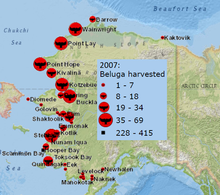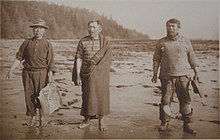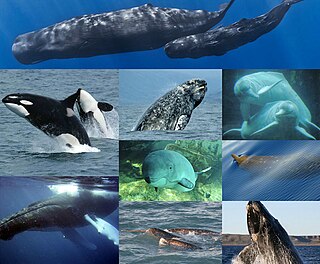
Cetacea is an infraorder of aquatic mammals belonging to the order Artiodactyla that includes whales, dolphins, and porpoises. Key characteristics are their fully aquatic lifestyle, streamlined body shape, often large size and exclusively carnivorous diet. They propel themselves through the water with powerful up-and-down movement of their tail which ends in a paddle-like fluke, using their flipper-shaped forelimbs to maneuver.

Whaling is the hunting of whales for their usable products such as meat and blubber, which can be turned into a type of oil that was important in the Industrial Revolution. Whaling was practiced as an organized industry as early as 875 AD. By the 16th century, it had become the principal industry in the Basque coastal regions of Spain and France. The whaling industry spread throughout the world and became very profitable in terms of trade and resources. Some regions of the world's oceans, along the animals' migration routes, had a particularly dense whale population and became targets for large concentrations of whaling ships, and the industry continued to grow well into the 20th century. The depletion of some whale species to near extinction led to the banning of whaling in many countries by 1969 and to an international cessation of whaling as an industry in the late 1980s.

Whales(Balaena) are a widely distributed and diverse group of fully aquatic placental marine mammals. As an informal and colloquial grouping, they correspond to large members of the infraorder Cetacea, i.e. all cetaceans apart from dolphins and porpoises. Dolphins and porpoises may be considered whales from a formal, cladistic perspective. Whales, dolphins and porpoises belong to the order Cetartiodactyla, which consists of even-toed ungulates. Their closest non-cetacean living relatives are the hippopotamuses, from which they and other cetaceans diverged about 54 million years ago. The two parvorders of whales, baleen whales (Mysticeti) and toothed whales (Odontoceti), are thought to have had their last common ancestor around 34 million years ago. Mysticetes include four extant (living) families: Balaenopteridae, Balaenidae, Cetotheriidae, and Eschrichtiidae. Odontocetes include the Monodontidae, Physeteridae, Kogiidae, and Ziphiidae, as well as the six families of dolphins and porpoises which are not considered whales in the informal sense.
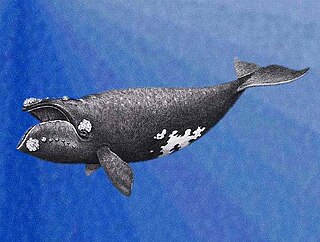
The North Pacific right whale is a very large, thickset baleen whale species that is extremely rare and endangered.

The Makah are an Indigenous people of the Pacific Northwest Coast living in Washington, in the northwestern part of the continental United States. They are enrolled in the federally recognized Makah Indian Tribe of the Makah Indian Reservation, commonly known as the Makah Tribe.

Japanese whaling, in terms of active hunting of whales, is estimated by the Japan Whaling Association to have begun around the 12th century. However, Japanese whaling on an industrial scale began around the 1890s when Japan started to participate in the modern whaling industry, at that time an industry in which many countries participated. Japan resumed commercial whaling in July 2019, and since then whaling activities have been confined to its territorial waters and exclusive economic zone.
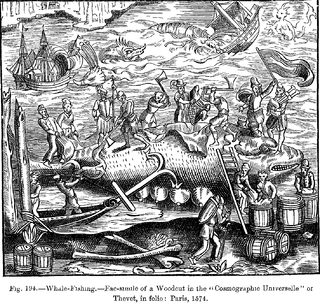
This article discusses the history of whaling from prehistoric times up to the commencement of the International Whaling Commission (IWC) moratorium on commercial whaling in 1986. Whaling has been an important subsistence and economic activity in multiple regions throughout human history. Commercial whaling dramatically reduced in importance during the 19th century due to the development of alternatives to whale oil for lighting, and the collapse in whale populations. Nevertheless, some nations continue to hunt whales even today.

Bequia is the largest island in the Grenadines at 7 square miles (18 km2). It is part of the country of Saint Vincent and the Grenadines and is approximately 15 kilometres (9.3 mi) from the nation's capital, Kingstown, on the main island, Saint Vincent. Bequia means "island of the clouds" in the ancient Arawak. The island's name was also 'Becouya' as part of the Grenadines.

Marine conservation activism is the efforts of non-governmental organizations and individuals to bring about social and political change in the area of marine conservation. Marine conservation is properly conceived as a set of management strategies for the protection and preservation of ecosystems in oceans and seas. Activists raise public awareness and support for conservation, while pushing governments and corporations to practice sound ocean management, create conservation policy, and enforce existing laws and policy through effective regulation. There are many different kinds of organizations and agencies that work toward these common goals. They all are a part of the growing movement that is ocean conservation. These organizations fight for many causes including stopping pollution, overfishing, whaling and by-catching, and supporting marine protected areas.

Commercial whaling in the United States dates to the 17th century in New England. The industry peaked in 1846–1852, and New Bedford, Massachusetts, sent out its last whaler, the John R. Mantra, in 1927. The Whaling industry was engaged with the production of three different raw materials: whale oil, spermaceti oil, and whalebone. Whale oil was the result of "trying-out" whale blubber by heating in water. It was a primary lubricant for machinery, whose expansion through the Industrial Revolution depended upon before the development of petroleum-based lubricants in the second half of the 19th century. Once the prized blubber and spermaceti had been extracted from the whale, the remaining majority of the carcass was discarded.
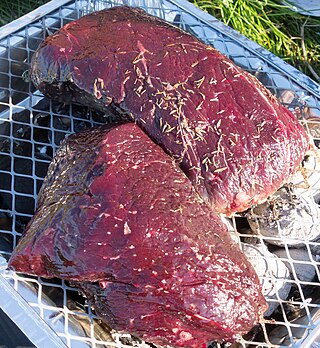
Whale meat, broadly speaking, may include all cetaceans and all parts of the animal: muscle (meat), organs (offal), skin (muktuk), and fat (blubber). There is relatively little demand for whale meat, compared to farmed livestock. Commercial whaling, which has faced opposition for decades, continues today in very few countries, despite whale meat being eaten across Western Europe and colonial America previously. However, in areas where dolphin drive hunting and aboriginal whaling exist, marine mammals are eaten locally as part of a subsistence economy: the Faroe Islands, the circumpolar Arctic, other indigenous peoples of the United States, St. Vincent and the Grenadines, some of villages in Indonesia and in certain South Pacific islands.
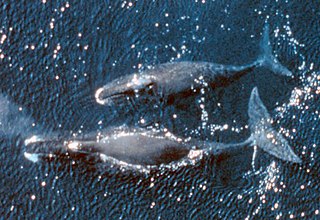
The bowhead whale is a species of baleen whale belonging to the family Balaenidae and is the only living representative of the genus Balaena. It is the only baleen whale endemic to the Arctic and subarctic waters, and is named after its characteristic massive triangular skull, which it uses to break through Arctic ice. Other common names of the species included the Greenland right whale, Arctic whale, steeple-top, and polar whale.

Whale conservation refers to the conservation of whales.

Marine mammals are a food source in many countries around the world. Historically, they were hunted by coastal people, and in the case of aboriginal whaling, still are. This sort of subsistence hunting was on a small scale and produced only localised effects. Dolphin drive hunting continues in this vein, from the South Pacific to the North Atlantic. The commercial whaling industry and the maritime fur trade, which had devastating effects on marine mammal populations, did not focus on the animals as food, but for other resources, namely whale oil and seal fur.

Subsistence hunting of the bowhead whale is permitted by the International Whaling Commission, under limited conditions. While whaling is banned in most parts of the world, some of the Native peoples of North America, including the Eskimo and Iñupiat peoples in Alaska, continue to hunt the Bowhead whale. Aboriginal whaling is valued for its contribution to food stocks and to cultural survival, although the days of commercial whaling in the United States and in Canada are over.

Barrow Canyon is a submarine canyon that straddles the boundary between the Beaufort and Chukchi seas. Compared to other nearby areas and the Canada Basin, the highly productive Barrow Canyon supports a diversity of marine animals and invertebrates.

A drift whale is a cetacean mammal that has died at sea and floated into shore. This is in contrast to a beached or stranded whale, which reaches land alive and may die there or regain safety in the ocean. Most cetaceans that die, from natural causes or predators, do not wind up on land; most die far offshore and sink deep to become novel ecological zones known as whale falls. Some species that wash ashore are scientifically dolphins, i.e. members of the family Delphinidae, but for ease of use, this article treats them all as "drift whales". For example, one species notorious for mass strandings is the pilot whale, also known as "blackfish", which is taxonomically a dolphin.

Whaling on the Pacific Northwest Coast encompasses both aboriginal and commercial whaling from Washington State through British Columbia to Alaska. The indigenous peoples of the Pacific Northwest Coast have whaling traditions dating back millennia, and the hunting of cetaceans continues by Alaska Natives and to a lesser extent by the Makah people.
Whaling in Canada encompasses both aboriginal and commercial whaling, and has existed on all three Canadian oceans, Atlantic, Pacific, and Arctic. The indigenous peoples of the Pacific Northwest Coast have whaling traditions dating back millennia, and the hunting of cetaceans continues by Inuit. By the late 20th century, watching whales was a more profitable enterprise than hunting them.

Russian whaling has been conducted by native peoples in the Chukotka region of Russia since at least 4,000 years ago by native Yupik and Chukchi people, but commercial whaling did not begin until the mid-19th century, when companies based in Finland sent out vessels to the Pacific. It was not until 1932 that modern pelagic whaling began to take off with the purchase of an American cargo ship which was renamed the Aleut, which was the only Soviet factory ship until World War II. After the war, with the need for a stronger Soviet economy and rapid industrialization of the country during the 1940s and 1950s, Soviet whaling took off and became a truly global industry. The first Soviet whalers reached the Antarctic during the 1946–47 season with the factory ship Slava and then underwent a rapid expansion during the late 1950s in which 5 new fleets were added within a 4-year span: Sovetskaya Ukraina in 1959, Yuriy Dolgorukiy in 1960, and Sovetskaya Rossiya in 1961 for the Antarctic, and finally two large fleets in 1963 for the North Pacific. Thus, by the early 1960s Soviet whaling had truly become a global industry, operating in every ocean except the North Atlantic and undertaking voyages that could last as long as seven months each. From 1964 to 1973, the Soviet Union was considered by some the biggest whaling nation in the world.

